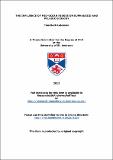The influence of mid-ocean ridges on euphausiid and pelagic ecology
Abstract
Chapters 1 & 2. Euphausiids comprise a major component of ecosystems in the pelagic realm, the
world’s largest habitat, but basin scale drivers of euphausiids diversity and abundance
are poorly understood. Mid-Ocean Ridges are the largest topographical feature in the
pelagic realm and their benthic and pelagic fauna have only just recently become the
focus of research. This thesis present new analyses on the drivers of euphausiids species
richness in the Atlantic and the Pacific, giving specific attention to the influence of Mid-Ocean Ridges. New information is given on the biogeography of euphausiids and
pelagic food-web trophology of the Mid-Atlantic Ridge, and on the biogeography of
pelagic decapods on the South-West Indian Ocean ridge.
3. A Generalized Additive Model framework was used to explore spatial patterns of
variability in euphausiid species richness (from recognized areas of occurrence) and in
numerical abundance (from the Continuous Plankton Recorder survey) in conjunction
with variability in a suite of biological, physical and environmental parameters on, and
at either side of, the Mid-Atlantic Ridge. Euphausiid species richness peaked in mid-latitudes
and was significantly higher on the ridge than in adjacent waters, but the ridge
did not influence numerical abundance in the top 10 m significantly. Sea surface
temperature (SST) was the most important single factor influencing both euphausiid
numerical abundance (-76.7%) and species richness (34.44%). Dissolved silicate
concentration, a proxy for diatom abundance, significantly increased species richness
(29.46%). Increases in sea surface height variance, a proxy for mixing, increased the
numerical abundance of euphausiids. GAM predictions of variability in species richness
as a function of SST and depth of the mixed layer were consistent with present theories,
which suggest that pelagic niche-availability is related to the thermal structure of the
near surface water.
4. Using a Generalized Additive Model in the Pacific, the main drivers of species
richness, in order of decreasing importance, were found to be sea surface temperature
(explaining 29.53% in species variability), salinity (20.29%), longitude (-15.01%,
species richness decreased from West to East), distance to coast (10.99%), and
dissolved silicate concentration (9.03%). An additional linear model poorly predicted
numerical abundance. The practical differences in drivers of species richness in the
Atlantic and Pacific Ocean were compared. Predictions of future species richness
changes in the Pacific and Atlantic were made using projected environmental change
from the IPCC A1B climate scenario, suggesting an increase in species richness in
temperature latitudes (30° to 60° N and S) and little to no change in low latitudes (20° N
to 20° S).
5. New baseline information is presented on biogeography, abundance and vertical
distribution of euphausiids along the Mid-Atlantic Ridge (40° to 62° N). 18 species
were recorded, with Euphausia krohni and Thysanoessa longicaudata being most
abundant. Eight species had not been recorded in the area previously. The Subpolar
Front is a northern boundary to some southern species, but not a southern boundary to
northern ubiquitous species that show submergence. Four major species assemblages
were identified and characterised in terms of spatial distribution and species
composition. Numerical abundance was highly variable but decreased by orders of
magnitude with depth. The Mid-Atlantic Ridge showed only a marginal effect on
euphausiid distribution and abundance patterns.
6. Zooplankton and micronektic invertebrate epi- and mesopelagic (0-200 and 200-800 m) vertical distribution (e.g. Euphausiacea, Decapoda, Amphipoda, Thecosomata,
Lophogastrida) on either side of the Subpolar Front of the Mid-Atlantic Ridge is
described. Dietary relationships are explored, using stable isotope ratios and fatty acid
trophic marker (FATM) composition. An increase in trophic level with size was
observed. Individuals from southern stations were higher in dinoflagellate Fatty Acid
Trophic Markers (FATM) (22:6(n-3)) and individuals from northern stations were
higher in Calanus spp and storage FATMs (20:1(n-9) and 22:1(n-9)) reflecting primary
production patterns in the two survey sectors. Observations on the geographical and
vertical variability in trophodynamics are discussed.
7. New baseline information is presented on the biogeography, abundance, and vertical
distribution of mesopelagic (200-1000 m), crustacean micronekton on- and offseamounts
of the South-West Indian Ocean Ridge (26° to 42° S). Species richness and
numerical abundance were typically higher near seamounts and lower over the abyssal
plains, with several species being caught uniquely on seamounts. Observations suggest
that the ‘oasis effect’ of seamounts conventionally associated with higher trophic levels
is also applicable to pelagic micronektic crustaceans at lower trophic levels. Biophysical
coupling of micronekton to seamounts may be an important factor controlling
benthopelagic coupling in seamount food-webs.
8. Euphausiid and pelagic diversity is driven primarily by geographical variability in
temperature, by longitudinal patterns in upwellings, and by variability in nutrient
concentration. Mid-Ocean Ridges modify pelagic ecology, by raising the seafloor and
by bringing in proximity true pelagic and bathypelagic predators associated with the
seabed. The increase in specialized fauna and biomass associated with ridges and
seamounts serves to deplete zooplankton in the near bottom layer (0-200 m) and affect
systems in and above the benthic boundary layer (<200 m from the seafloor), and the
benthopelagic faunal layer. Mid-Ocean Ridges may serve to structure pelagic faunal
distribution, and increase the overall diversity of the world ocean. The influence of
ridges in the ocean basin may be comparable to that of hedges in a farmland; whilst
delimiting the extent of crops (or zooplankton assemblages), hedges serve as local
hotspots of mammal and avian diversity.
Type
Thesis, PhD Doctor of Philosophy
Collections
Items in the St Andrews Research Repository are protected by copyright, with all rights reserved, unless otherwise indicated.

